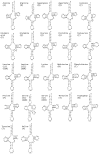The complete mitochondrial genome of the stomatopod crustacean Squilla mantis
- PMID: 16091132
- PMCID: PMC1199596
- DOI: 10.1186/1471-2164-6-105
The complete mitochondrial genome of the stomatopod crustacean Squilla mantis
Abstract
Background: Animal mitochondrial genomes are physically separate from the much larger nuclear genomes and have proven useful both for phylogenetic studies and for understanding genome evolution. Within the phylum Arthropoda the subphylum Crustacea includes over 50,000 named species with immense variation in body plans and habitats, yet only 23 complete mitochondrial genomes are available from this subphylum.
Results: I describe here the complete mitochondrial genome of the crustacean Squilla mantis (Crustacea: Malacostraca: Stomatopoda). This 15994-nucleotide genome, the first described from a hoplocarid, contains the standard complement of 13 protein-coding genes, 22 transfer RNA genes, two ribosomal RNA genes, and a non-coding AT-rich region that is found in most other metazoans. The gene order is identical to that considered ancestral for hexapods and crustaceans. The 70% AT base composition is within the range described for other arthropods. A single unusual feature of the genome is a 230 nucleotide non-coding region between a serine transfer RNA and the nad1 gene, which has no apparent function. I also compare gene order, nucleotide composition, and codon usage of the S. mantis genome and eight other malacostracan crustaceans. A translocation of the histidine transfer RNA gene is shared by three taxa in the order Decapoda, infraorder Brachyura; Callinectes sapidus, Portunus trituberculatus and Pseudocarcinus gigas. This translocation may be diagnostic for the Brachyura. For all nine taxa nucleotide composition is biased towards AT-richness, as expected for arthropods, and is within the range reported for other arthropods. Codon usage is biased, and much of this bias is probably due to the skew in nucleotide composition towards AT-richness.
Conclusion: The mitochondrial genome of Squilla mantis contains one unusual feature, a 230 base pair non-coding region has so far not been described in any other malacostracan. Comparisons with other Malacostraca show that all nine genomes, like most other mitochondrial genomes, share a bias toward AT-richness and a related bias in codon usage. The nine malacostracans included in this analysis are not representative of the diversity of the class Malacostraca, and additional malacostracan sequences would surely reveal other unusual genomic features that could be useful in understanding mitochondrial evolution in this taxon.
Figures



Similar articles
-
The complete mitochondrial genome of the common sea slater, Ligia oceanica (Crustacea, Isopoda) bears a novel gene order and unusual control region features.BMC Genomics. 2006 Sep 20;7:241. doi: 10.1186/1471-2164-7-241. BMC Genomics. 2006. PMID: 16987408 Free PMC article.
-
The complete sequence of the mitochondrial genome of the crustacean Penaeus monodon: are malacostracan crustaceans more closely related to insects than to branchiopods?Mol Biol Evol. 2000 Jun;17(6):863-74. doi: 10.1093/oxfordjournals.molbev.a026366. Mol Biol Evol. 2000. PMID: 10833192
-
The complete mitochondrial genome of the Hawaiian anchialine shrimp Halocaridina rubra Holthuis, 1963 (Crustacea: Decapoda: Atyidae).Gene. 2007 Jun 1;394(1-2):35-44. doi: 10.1016/j.gene.2007.01.009. Epub 2007 Jan 26. Gene. 2007. PMID: 17317038
-
A case for evolutionary genomics and the comprehensive examination of sequence biodiversity.Mol Biol Evol. 2000 Dec;17(12):1776-88. doi: 10.1093/oxfordjournals.molbev.a026278. Mol Biol Evol. 2000. PMID: 11110893 Review.
-
The biased nucleotide composition of the HIV genome: a constant factor in a highly variable virus.Retrovirology. 2012 Nov 6;9:92. doi: 10.1186/1742-4690-9-92. Retrovirology. 2012. PMID: 23131071 Free PMC article. Review.
Cited by
-
The Complete Mitochondrial Genome of Corizus tetraspilus (Hemiptera: Rhopalidae) and Phylogenetic Analysis of Pentatomomorpha.PLoS One. 2015 Jun 4;10(6):e0129003. doi: 10.1371/journal.pone.0129003. eCollection 2015. PLoS One. 2015. PMID: 26042898 Free PMC article.
-
The First Complete Mitochondrial Genome of the Genus Litostrophus: Insights into the Rearrangement and Evolution of Mitochondrial Genomes in Diplopoda.Genes (Basel). 2024 Feb 18;15(2):254. doi: 10.3390/genes15020254. Genes (Basel). 2024. PMID: 38397243 Free PMC article.
-
Phylogenetic implications of the complete mitochondrial genome of Ogcogastersegmentator (Westwood, 1847) and first record of the genus Ogcogaster Westwood, 1847 from China (Neuroptera, Myrmeleontidae, Ascalaphinae).Biodivers Data J. 2022 Jul 7;10:e85742. doi: 10.3897/BDJ.10.e85742. eCollection 2022. Biodivers Data J. 2022. PMID: 36761650 Free PMC article.
-
The complete mitochondrial genome of Platygaster robiniae (Hymenoptera: Platygastridae): A novel tRNA secondary structure, gene rearrangements and phylogenetic implications.Int J Parasitol Parasites Wildl. 2022 Jun 23;18:249-259. doi: 10.1016/j.ijppaw.2022.06.007. eCollection 2022 Aug. Int J Parasitol Parasites Wildl. 2022. PMID: 35800109 Free PMC article. Review.
-
The mitochondrial genome of Euphausia superba (Prydz Bay) (Crustacea: Malacostraca: Euphausiacea) reveals a novel gene arrangement and potential molecular markers.Mol Biol Rep. 2010 Feb;37(2):771-84. doi: 10.1007/s11033-009-9602-7. Epub 2009 Jul 4. Mol Biol Rep. 2010. PMID: 19578978
References
-
- García-Machado E, Pempera M, Dennebouy N, Oliva-Saurez M, Mounolou JC, Monnerot M. Mitochondrial genes collectively suggest the paraphyly of Crustacea with respect to Insecta. J Mol Evol. 1999;49:142–149. - PubMed
Publication types
MeSH terms
Substances
LinkOut - more resources
Full Text Sources

